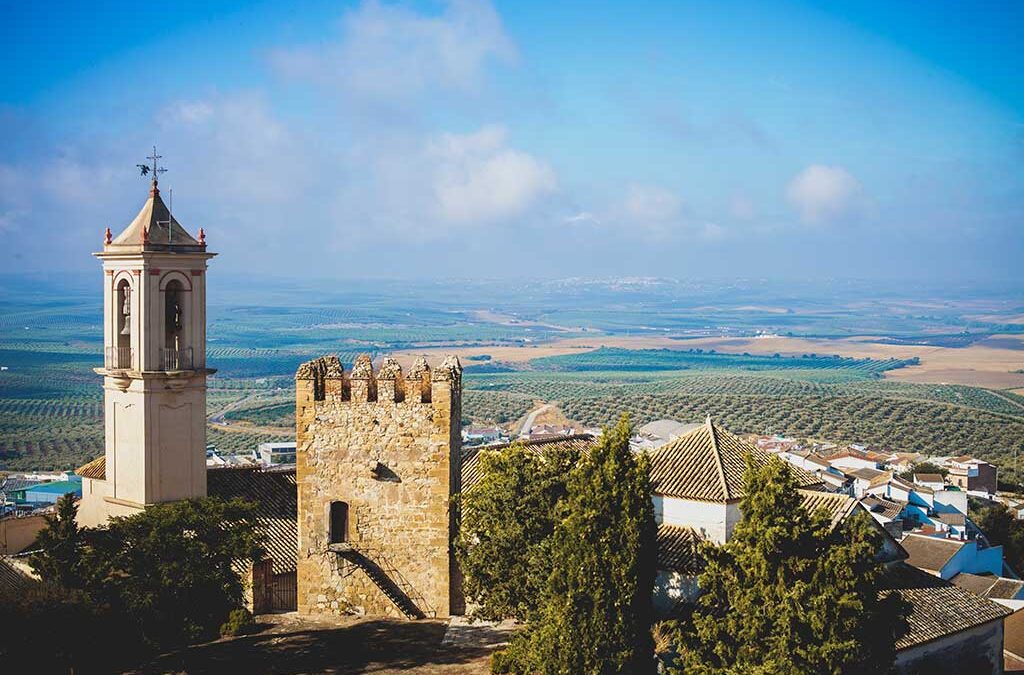WEEKLY ROUTE
Espejo – Montilla – Fernán Núñez – Montemayor
Text: Rosa Marqués @rocamarca | Photography: Javier Portero @estudio.casa.palop | Main picture: The views of the Cordovan countryside, from the terraces of Espejo Castle, open to the public.
Reading time: 8 minutes
We visit the towns of Espejo, Montilla, Fernán Núñez and Montemayor, in the Montilla-Moriles wine region to give you ideas on how to enjoy the pleasures to be found al fresco in the Cordoba countryside.
The countryside in September, with the grape harvest in all its splendour in scenic landscapes such as the Sierra de Montilla and Moriles Altos, is alone worth a trip to this region sprinkled with picturesque white villages on the folds of the surrounding hills where rural life remains deep-rooted.
A route through the Cordoba countryside beneath delightful spots of cooling shade where there is always a fresh breeze. At the end of this article, you will find all the information you need to organise the visit yourself.
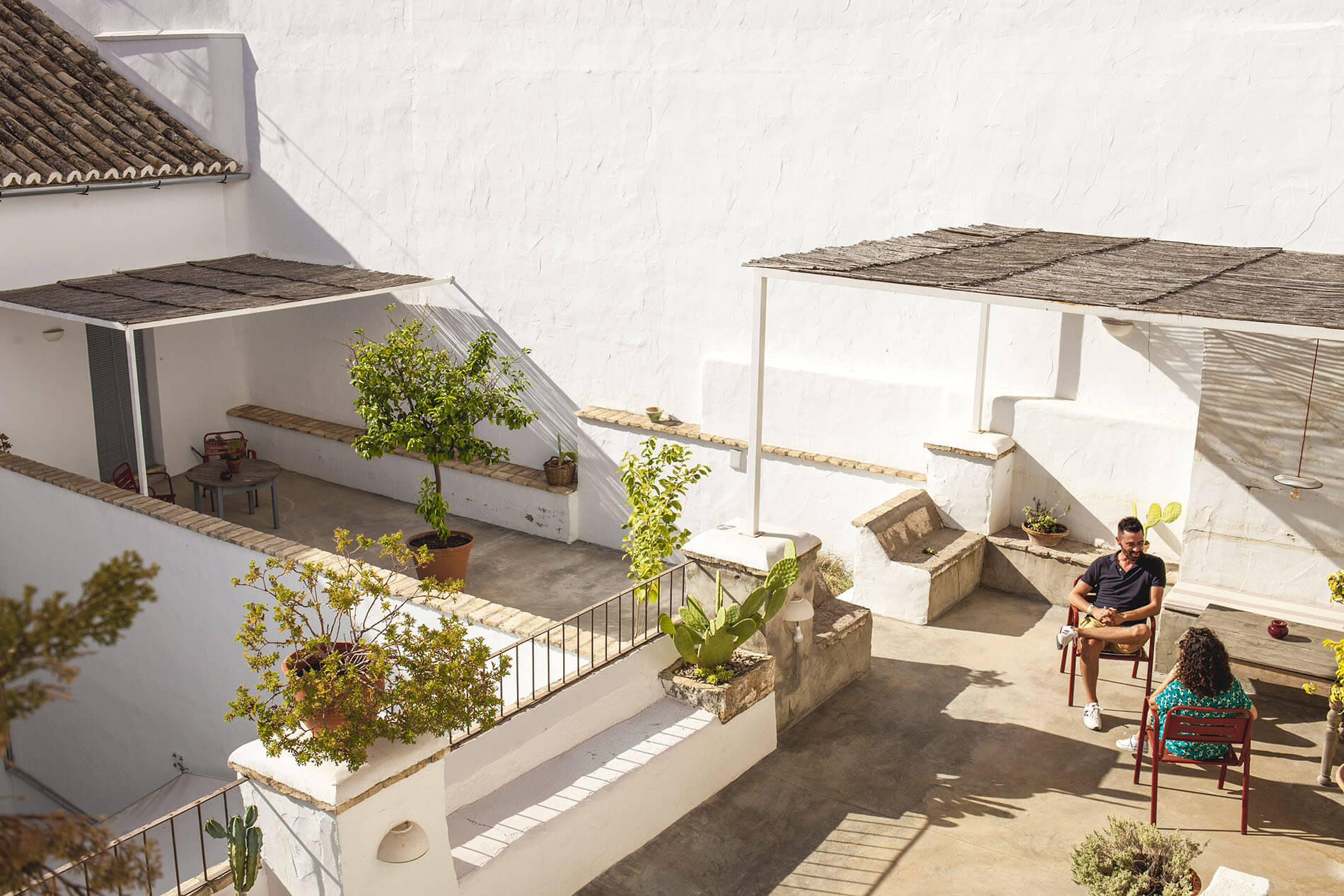
More terraces with views: These are the ones of the boutique hotel Casa Almara, in Espejo, an old restored 19th century house.
FRIDAY AFTERNOON
Espejo; to eat, sleep and rest like a king
To be greeted with a spectacular view, time your arrival at the town of Espejo at sunset. The imposing castle, one of the best preserved castles of Cordoba, has a romantic night lighting and a magical atmosphere which invites you for an evening stroll. And best of all, it can be visited in its entirety.
The imposing castle dominates the town of Espejo, located at the top of a hill, its monumental structure towers above the town. From the terraces of the castle you can see the countryside in all its extension. A keen eye will be able to observe an informative landmark, located on the Cerro de las Dehesillas. A place where the famed photograph “The Falling Soldier” was taken by Robert Capa and his partner Gerda Taro in 1936, during the Spanish Civil War. But if we talk about photographs taken in Espejo -a town of little more than 3,300 inhabitants- that have gained international acclaim, then the one awarded by the National Gallery in London takes the prize. The image, by the Cordoba astronomer and moon chaser, Paco Bellido, shows a huge full moon behind Espejo Castle. The London art gallery used it to illustrate the cover of one of its famous catalogs. The Espejo postcard went viral.
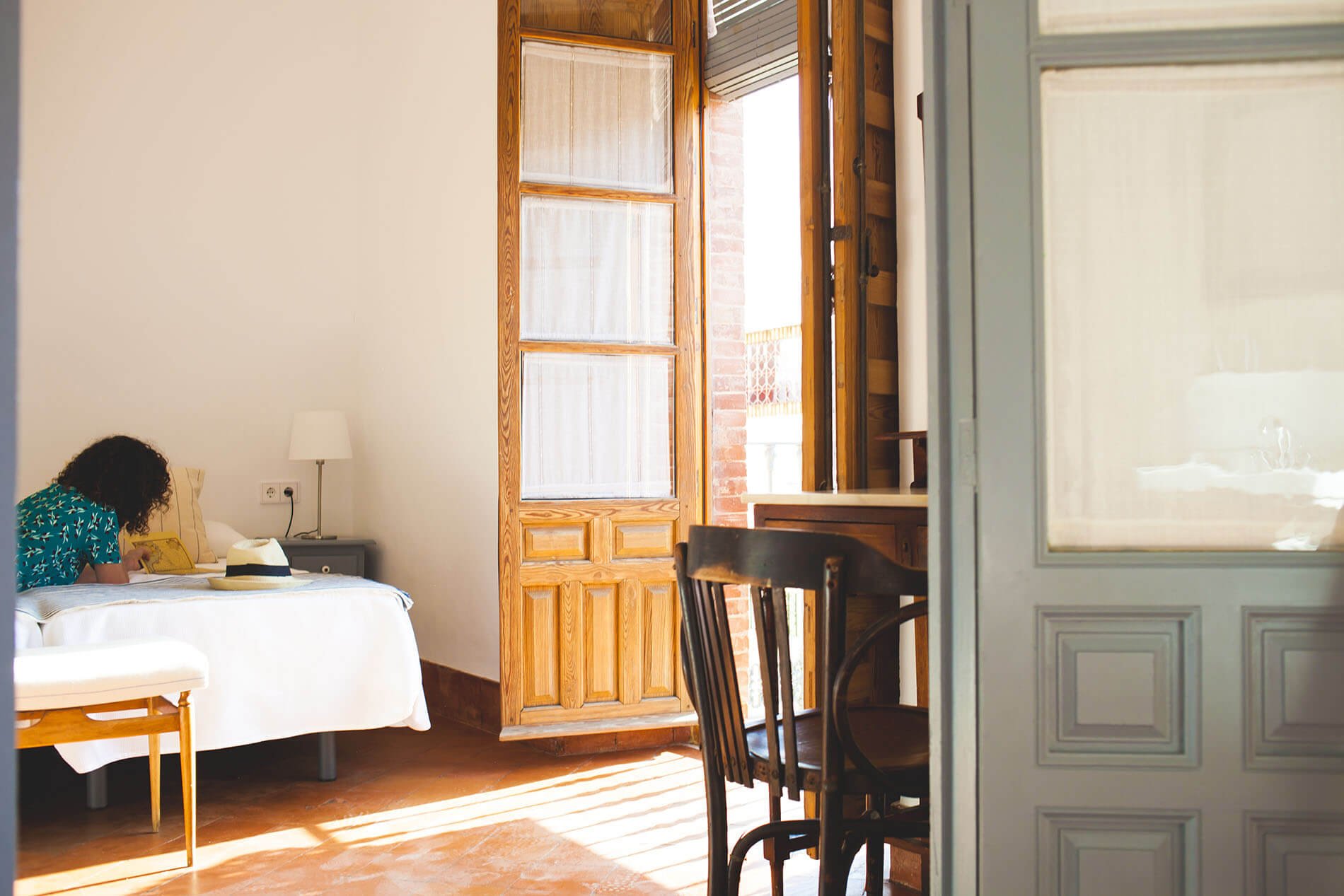
Authentic floors, natural woods… the handcrafted restoration is impeccable in the 8 commodious rooms.
But Espejo is much more than these photographs. In this peaceful town of infinite slopes and white-washed walls, where the life of always, that of the land, is still palpable, making it the perfect starting point for your journey through the region. Noticeable as soon as you arrive, when the locals greet you through Las Calleras, the boulevard converted into the social center of the town, threshing floors in yesteryear, hence its current name, Las Calleras, where wheat was threshed and sold. Wheat. Like the scenes typically shown on picture postcards, you will see billowing wheat fields on the adjacent secondary roads as you approach the town, making you want to get out of the car and take some photos of the rural landscape.
Very close to Las Calleras, our accommodation, Casa Almara, an old 19th century house converted into a charming boutique hotel, with only 8 rooms, elegant and authentic. Bricio opens the door for us with a smile. The house has been restored over three years and the result is impeccable: antique doors and floors, whitewashed walls, characteristic furniture, a bright courtyard welcomes us and some decorative elements brought from Morocco by its owner, Ivan, an adopted son of Espejo married to local woman from the town, together they have bet heavily on the territory Montilla-Moriles. Quality and authenticity in equal parts.
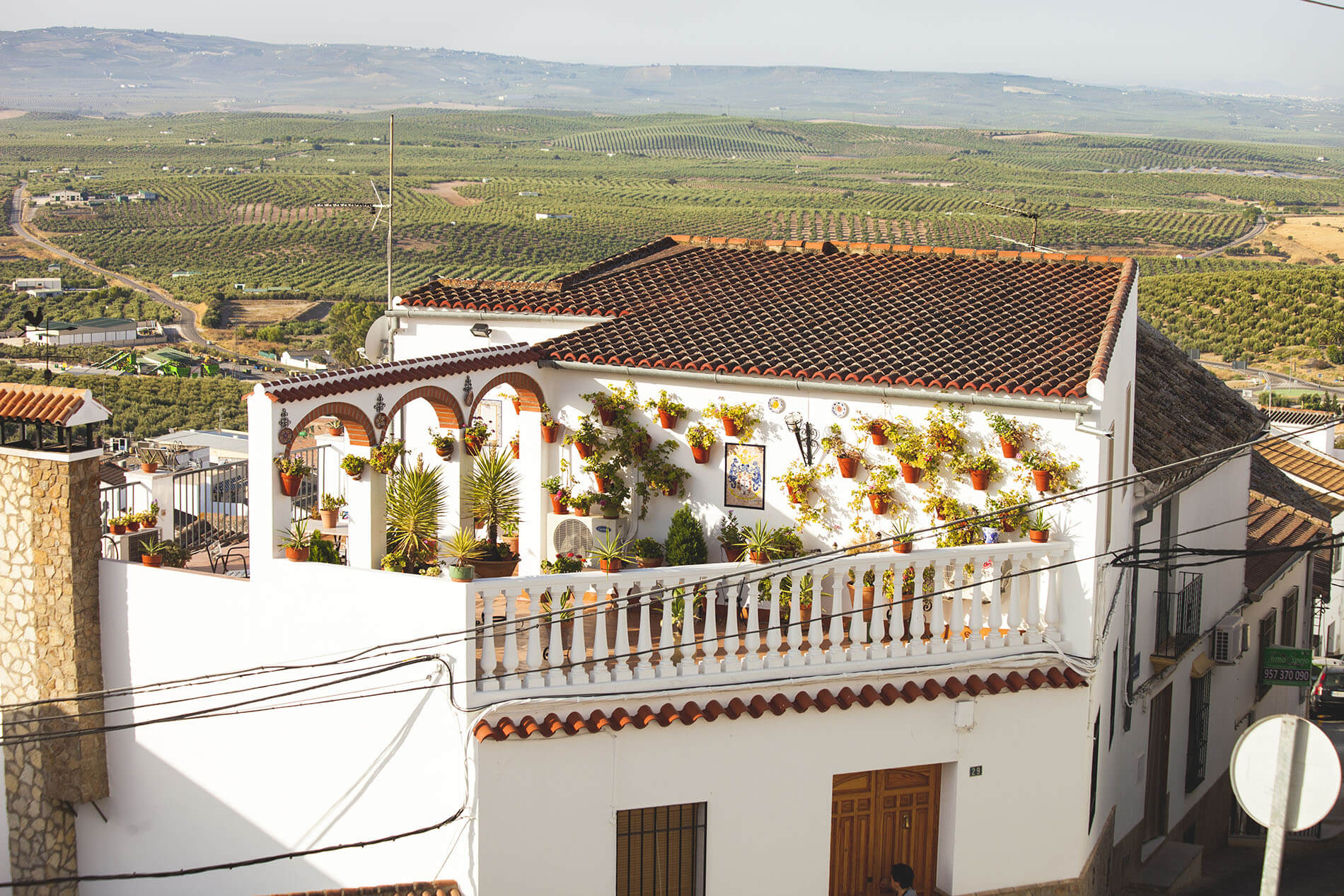
Espejo is located on a hill. The photojournalist Robert Capa walked here and took the famous photo “The Falling Soldier.”
That night, after watching the sunset from one of the hotel’s fabulous terraces, overlooking the Cordovan countryside, and after having tasted some of the town’s chacinas -their chorizos and morcillas are very famous and we bought them as soon as we arrived- and a toast with a glass of Fino, wine from Montilla-Moriles, we went out for dinner in Las Calleras and then returned to rest. The following day we had booked to visit the majestic castle.
SATURDAY MORNING
The Castle of Espejo; not to be missed
If the night lighting of this fortress, that was and still is a palatial home, conquered you at night, the visit to the interior will do so even more, also apt for children. It is a history lesson. The well-preserved castle of Espejo is a living history museum of the region. The majority of the rooms are equipped and open to tourism. Joanna the Mad also stayed there, and this fortress dates back to the 13th and early 14th centuries – although it underwent several modifications after the Spanish Civil War.
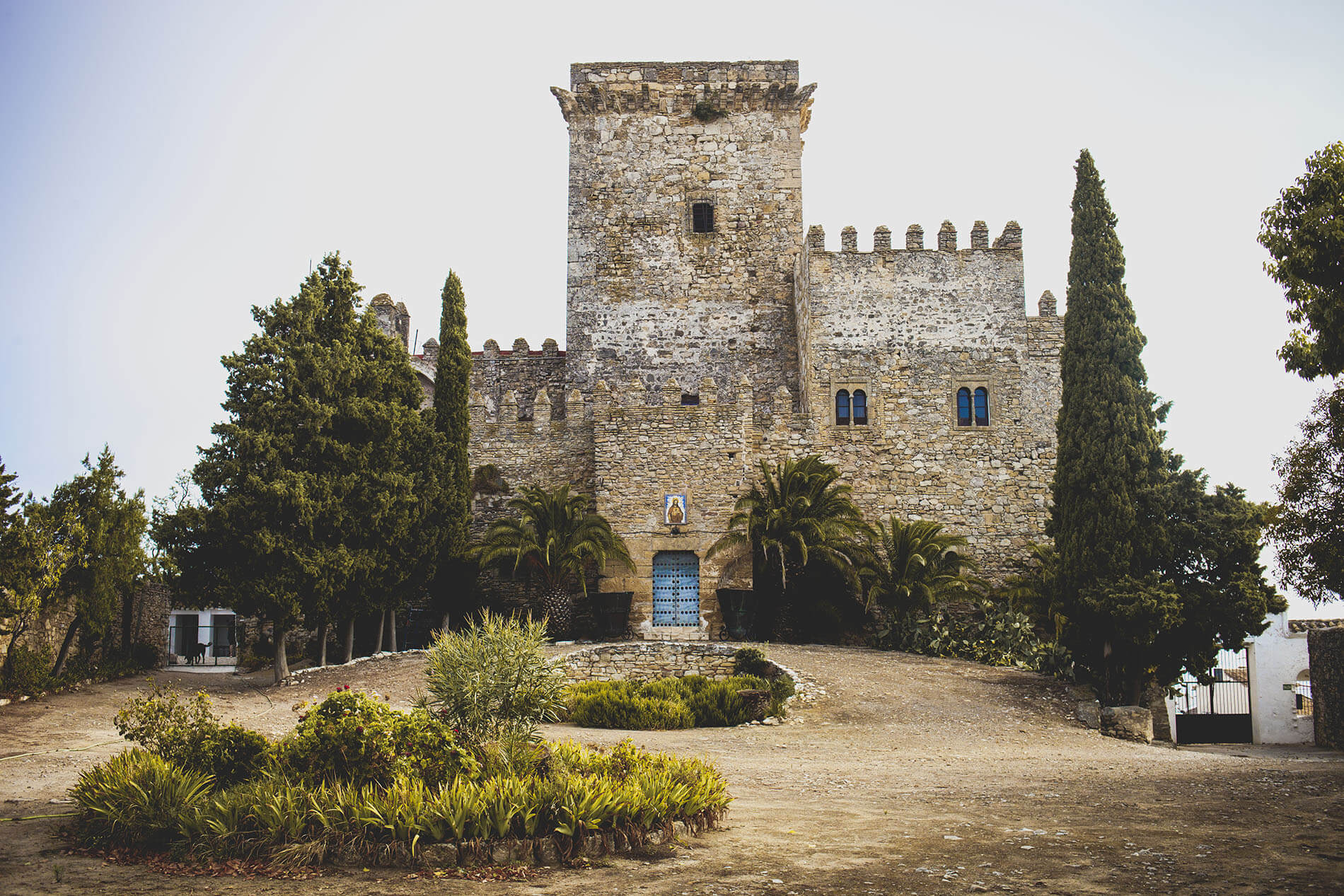
The Espejo Castle is a must see (also suitable for children) that leaves you wanting more.
Today the castle of Espejo is still private property. It belongs to the four heirs of Angela Maria Tellez-Giron, Duchess of Estrada, XVI Duchess of Osuna, who in turn was the daughter of the much-loved in town, Petra Duque de Estrada, who lived for long periods in this fortress and built schools for the most disadvantaged children in the town. Her castle-palace is full of memories of her and her ancestors, antique furniture, works of art… . The house of Osuna was one of the four most important noble families in Spain.
The library, recently opened to the public, also keeps an endless number of documents, files, manuscripts and ancient books, such as a huge 15th century volume that is on view to the visitor and is a transfer of powers from the county of Ampuria, written by hand and with coats of arms in gold. The dining room, with the table laid out, the chapel, the courtyard, the kitchen, the lookout, the library … are all visited and leaves you wanting more.
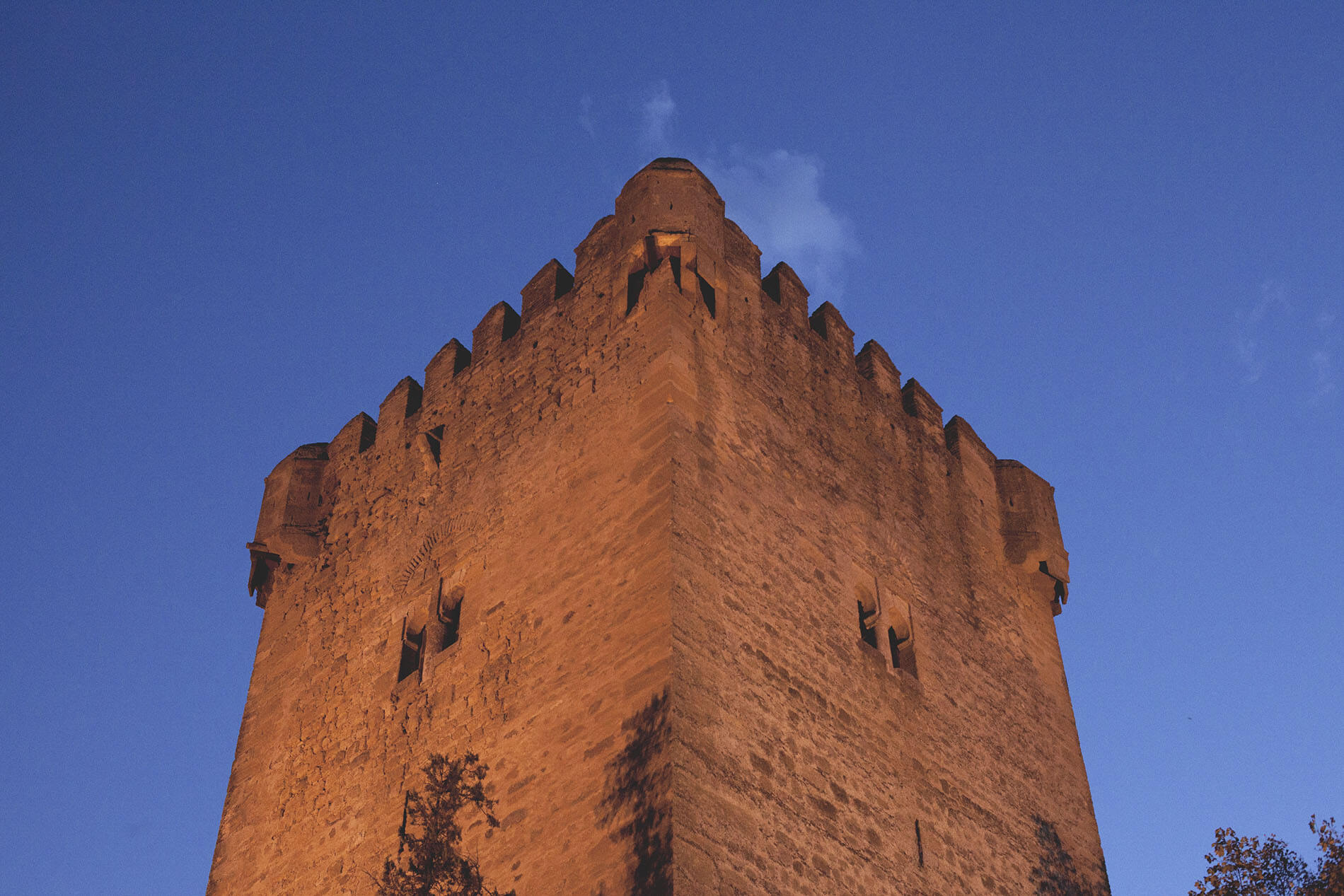
The movement “Let’s Visit the Castle” aims to re-open the castle of Montemayor to the public, currently closed.
Montemayor; a walk around the closed Castle
Espejo to Montemayor is a 15 minutes drive in the car. A drive which proffers evocative agricultural landscapes: wheat, vineyards and olive trees, Mediterranean features that connects the present and the past without the need for further description. Only countryside and the four seasons. Montemayor was the ancient Ulia, an important Ibero-Roman city, scene of the civil wars between Julius Caesar and Pompey in 46 BC.
The relaxed atmosphere in this town is palpable as soon as you arrive. People look into your eyes and greet you as if they have known you all your life. The pace is slow and the surroundings of the castle beautiful. This is the time when the sun’s rays weave magic through the Cordovan countryside and we seek refuge in the Ulia Museum, not wanting to miss out on the so-called ‘Venus de Montemayor’ and some other jewels of the museum. But first, a walk around the exterior of this other spectacular castle, though closed to the public and to tourism in general, the visit is worthwhile. Meanwhile, the whole town has come together, in a movement led by its mayor called ‘Visit the Castle’, in an attempt to re-open its doors to the public. I’m sure it won’t be long before they do. And when they do, we’ll be back to visit this magnificent fortress.
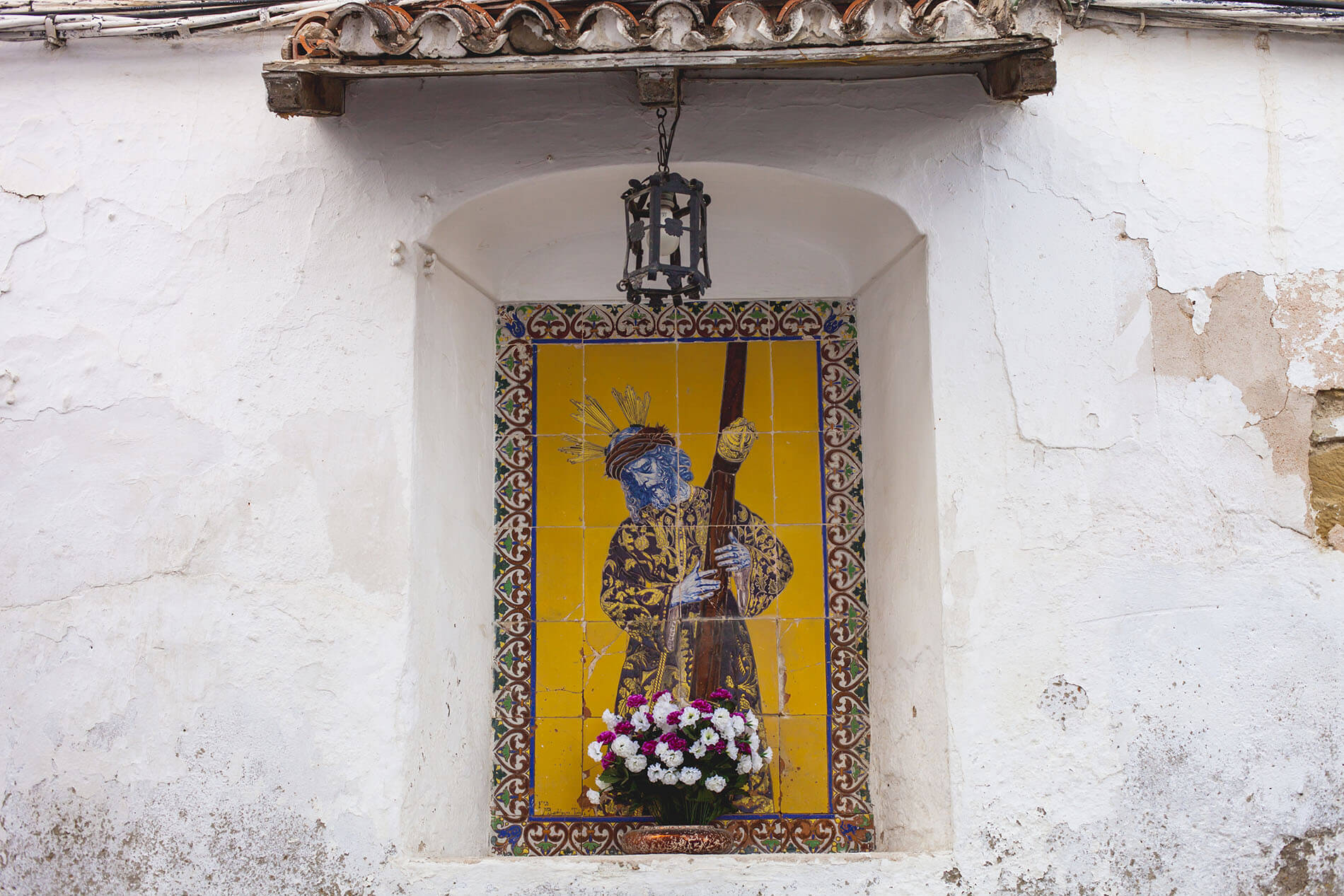
Details of a tile of “Jesus the Nazarene” along the streets of Espejo.
From the viewpoint of the countryside, once again we let our eyes gaze over the horizon, the sun high above our heads. Pink oleanders on white, luminous walls, hermitages and charming village squares like that of Jesús el Nazareno, townsmen and women seek shelter from the sun under doors on which hang thick curtains, with curious rural motifs, which are intended to keep the doors open and let in the fresh air whilst maintaining privacy… and so we walk until we reach the charismatic Plaza de la Constitución of the town. A huge poster hangs over the facade of the Town Hall: «In defence of the traditional olive grove and our farmers». This village has character.
The Venus of Montemayor in the Ulia Museum
The Archaeological Museum of Ulia has one of the best collections of sculptures from the Roman period in the Cordoba countryside. The famous Venus of Montemayor is a female head that has a headdress carved in stone. The museum is also working on several lines of research with the University Carlos III of Madrid and relatively recently they located a set of four large Iberian iron wheels, practically intact, in an almost perfect state of conservation. Dated around the 4th century BC they are not yet on display, but they give an idea of the archaeological wealth of ancient Ulia.
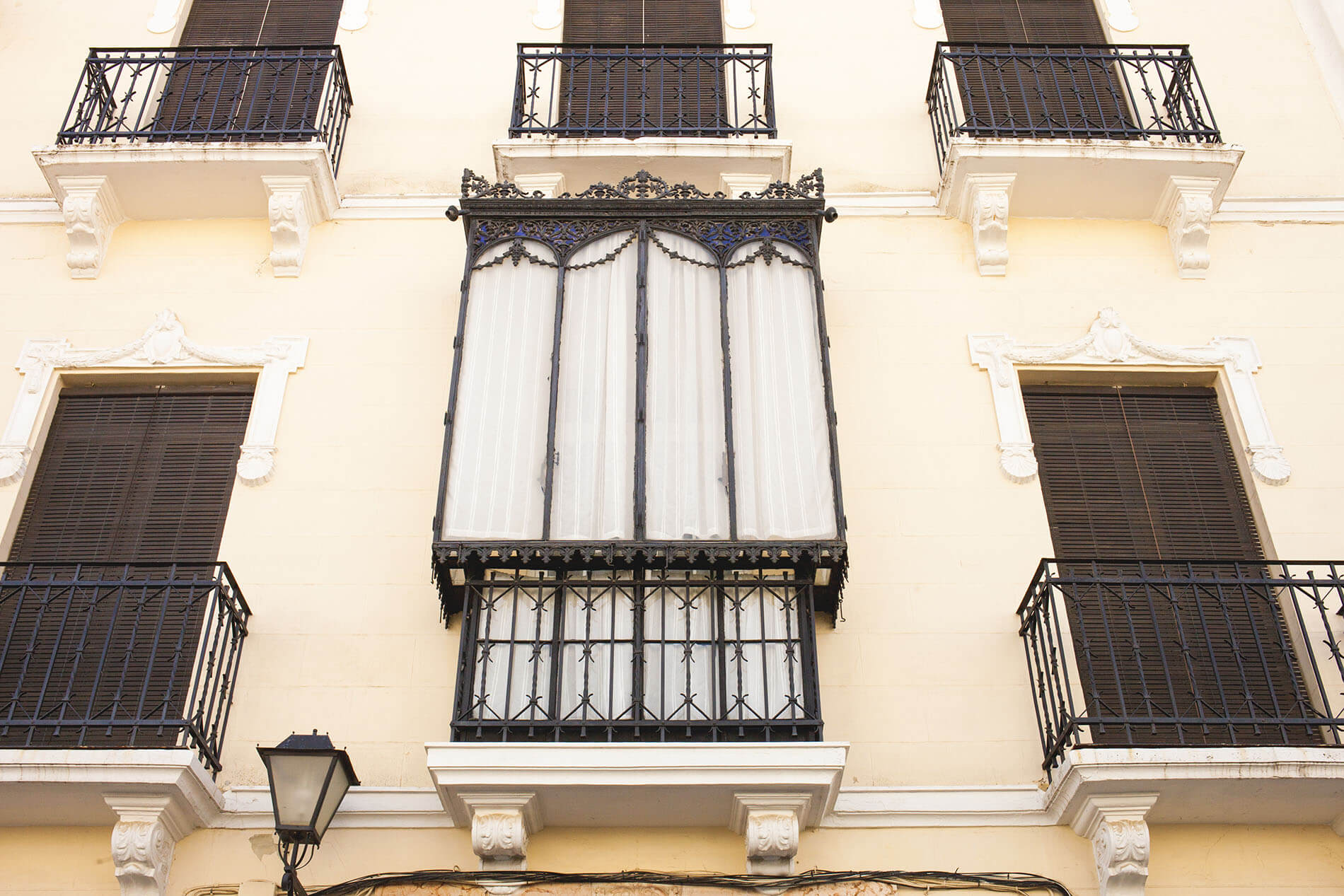
Manorial facades in Las Calleras, today Espejo’s social center. In the past where the threshing floors were.
It is lunchtime and we search for a quaint restaurant where we can eat well and drink some wines from the Montilla-Moriles region. Following the spot-on recommendations of one of the locals, we end up in La Posada del Castillo. After a copious luncheon, we return to Espejo for a siesta. As the sun sets once again, we set off to Fernán Núñez. During some nights of this atypical summer the Ducal Palace has been opened for visits.
SATURDAY NIGHT
Fernán Núñez, the night is magic in the garden of the Ducal Palace
You suddenly appear in the Plaza de Armas that houses the Ducal Palace of Fernán Núñez, built in 1783 on the ruins of a former castle that was destroyed by the 1755 Lisbon earthquake, the feeling is that of being in some lost village in Tuscany or perhaps in the Portuguese Alentejo. The contrast of the earthy red ochre, almagra, against a white backdrop floods everything.
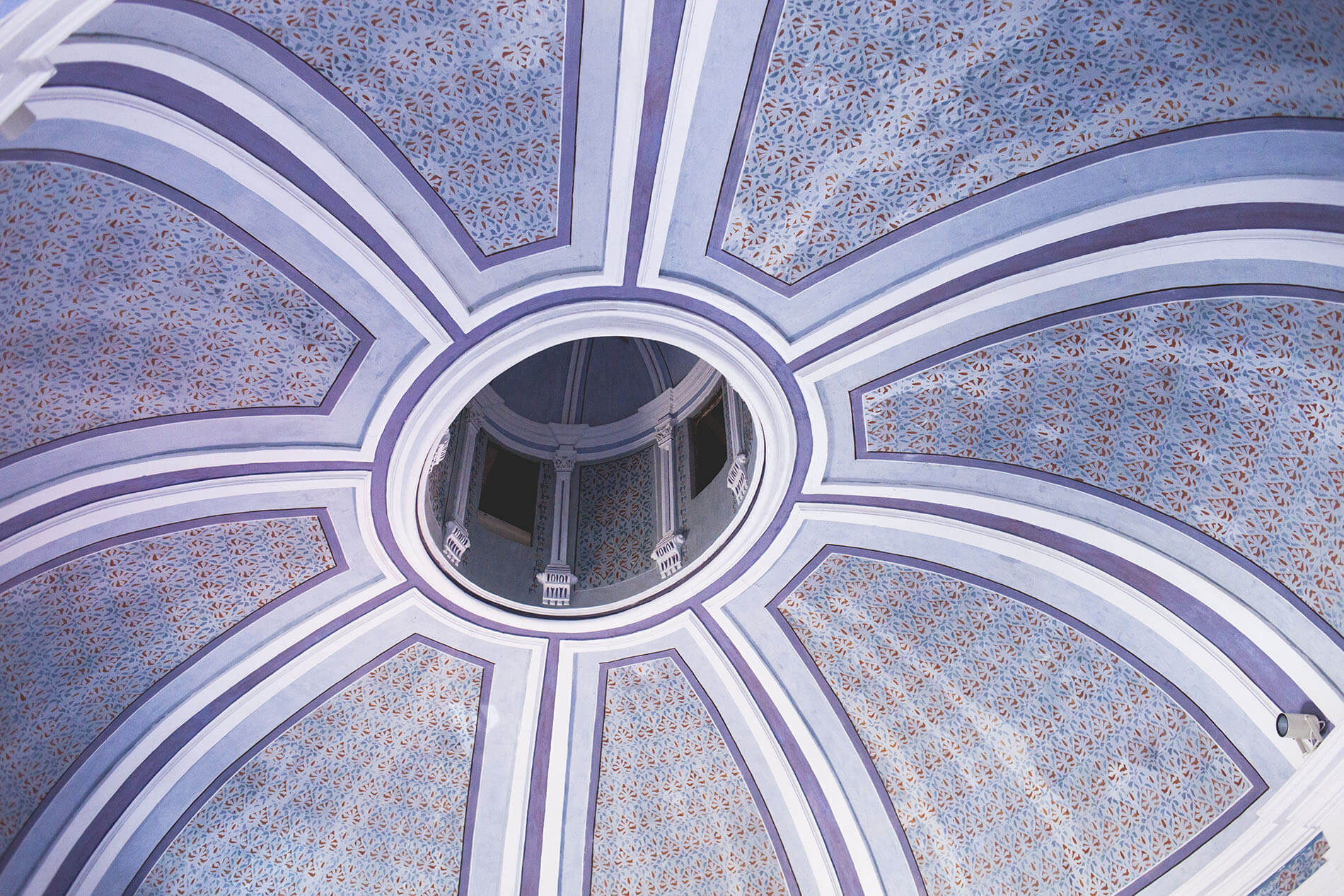
The dome of the chapel of Santa Escolástica, in the Ducal Palace of Fernán Núñez, recently restored.
There are several hypotheses about the source of inspiration for the Ducal Palace, but one of them is that Carlos José Gutiérrez de los Ríos, VI Count of Fernán Núñez, who was ambassador in Lisbon and in Paris during the French Revolution, was inspired to build it in the style of the Necessidades Palace of the Portuguese capital. It is precisely this Portuguese air, this nostalgia, that is projected from this civil building, the most beautiful and important in the province of Cordoba.
The Palace has undergone almost a decade of restoration work in order to re-open its doors definitively. Although the Chapel of Santa Escolástica, the Administrator’s Room and the Palatine staircase are almost finished and give an idea of the neoclassical beauty of the building that was built by the VI Count. The chapel, breathtaking in blue tones, was dedicated to his sister, Scholastica, who died at a young age.
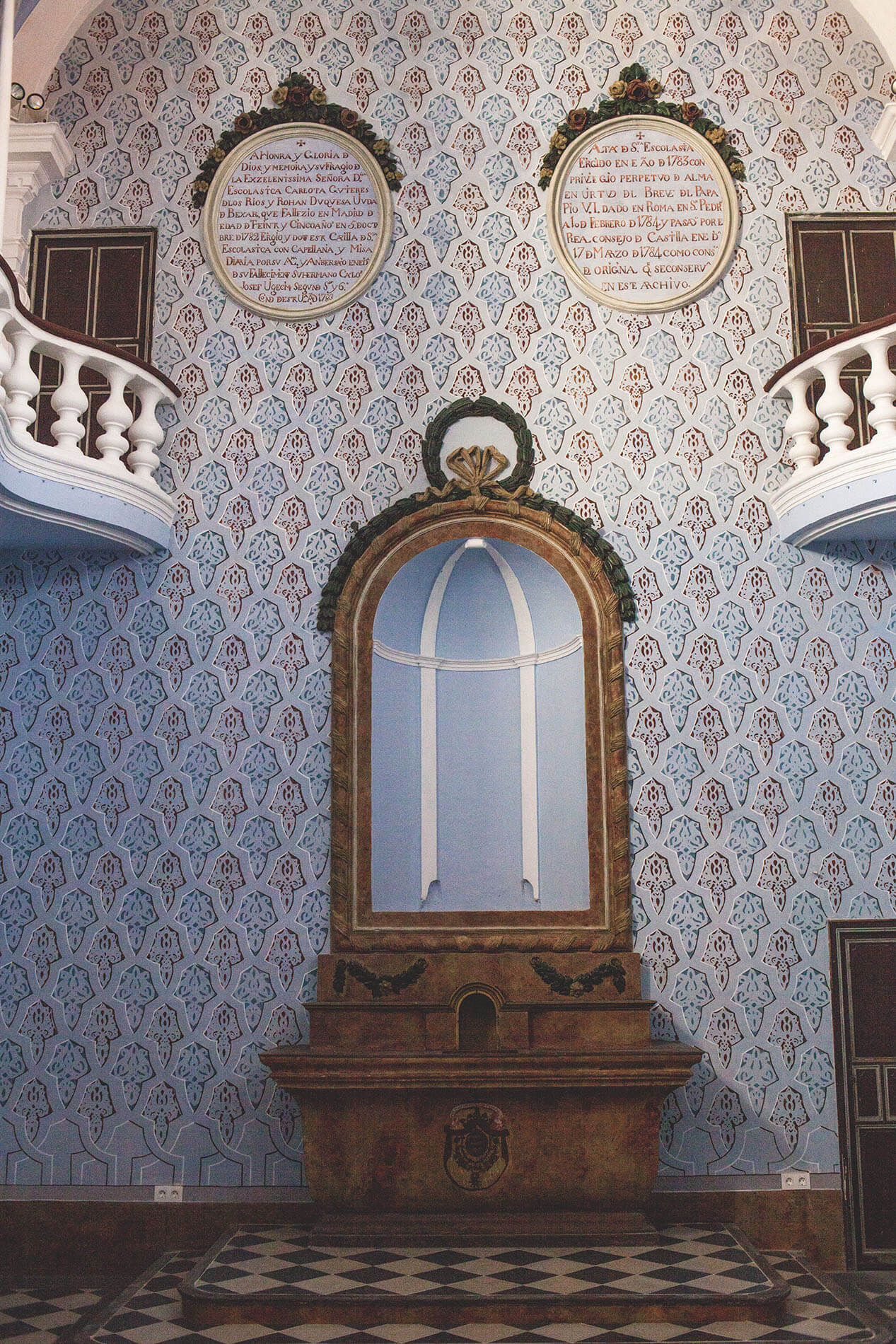
Blue fantasy; the chapel of St. Scholastica, one of the most beautiful areas of the palace.
The visit is worthwhile and should not be missed at night. On some summer nights the doors to the gardens are opened for concerts, poetic recitals and cultural activities: in short, for the enjoyment of the citizens, a shame there is always a maze of cars parked in this spectacular square which detracts the vision as a whole.
The Palace was an alcazar and fortress before it became a palatial residence and, if you look at it, one of the two towers that crown the building is built on the remains of the old fortress, or tower of Fernán Núñez, which was conquered by the Arabs and can be seen through a gate, which leads to the Patio de las Caballerizas. There, along with the cannon, you can see the eight mortars embedded in the tower. It was the II Count of Fernán Núñez who took them from the English admiral Robert Blake, in 1657, in the blockade of Cadiz.
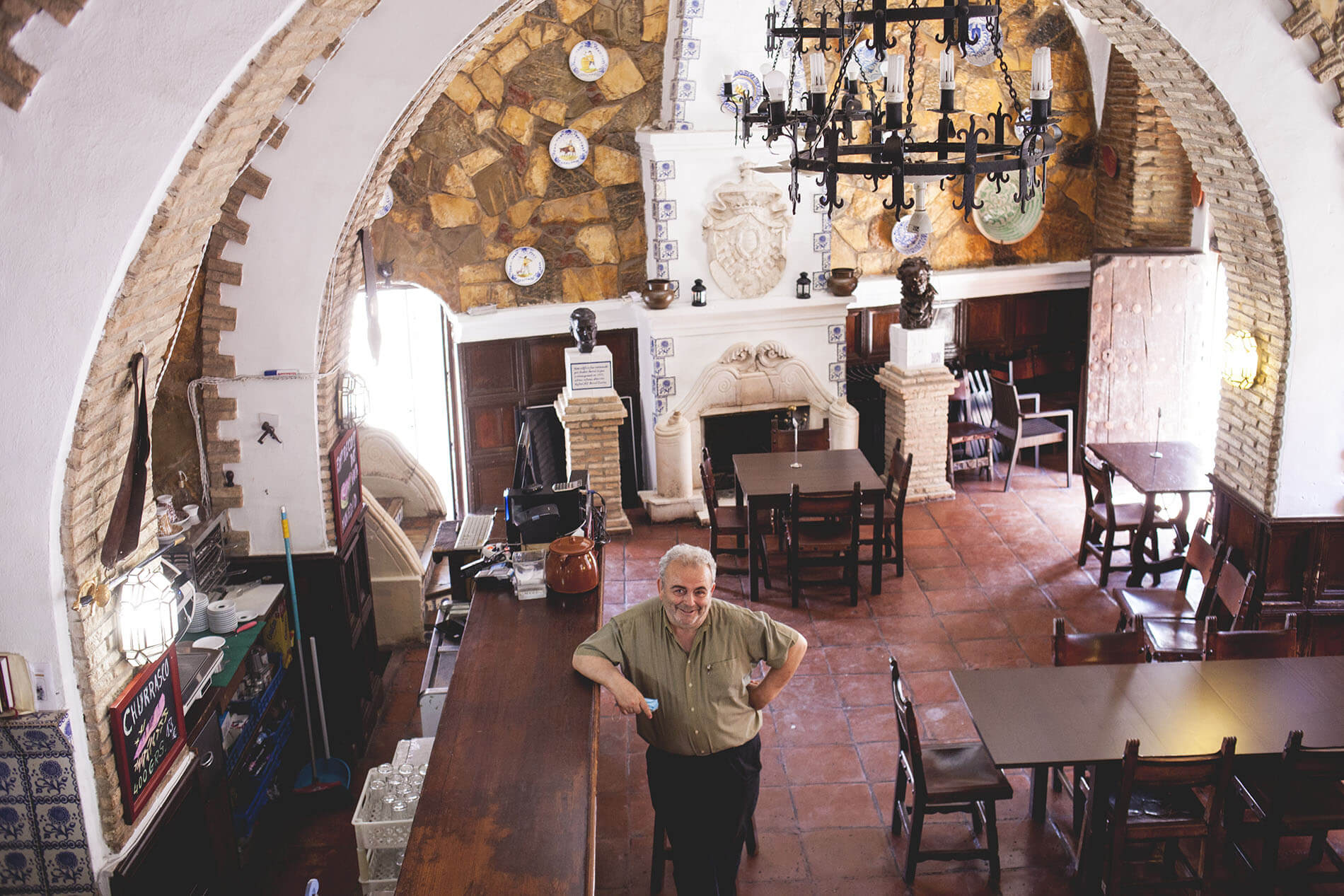
Andrés Berral in his tavern, the oldest in Spain, since 1669, El Mesón del Duque, in Fernán Núñez.
The greatness and spectacularity of the square is not only due to the building itself, but to the impressive array of the urban complex built by a man ahead of his time. The VI Count built the Plaza de Armas, the stables, some schools for disadvantaged children (inspired as it was by the French Revolution) and a tavern, originally founded by the III Count in 1669 over an already existing one. The tavern could be said to be one of the oldest in Spain.
This amazing place, the oldest wine establishment in the peninsula, contains a history worthy of knowing – with luck and time, the owner will give you a tour. A perfect place to be served the great wines of the Montilla-Moriles region. Regardless, to walk around the premises and see the 300 year old earthenware clay vessels in one of the rooms or in the old barn is a unique experience, and to finish off, try the oxtail croquettes served on the terrace of the premises overlooking the Plaza de Armas of Fernán Núñez.
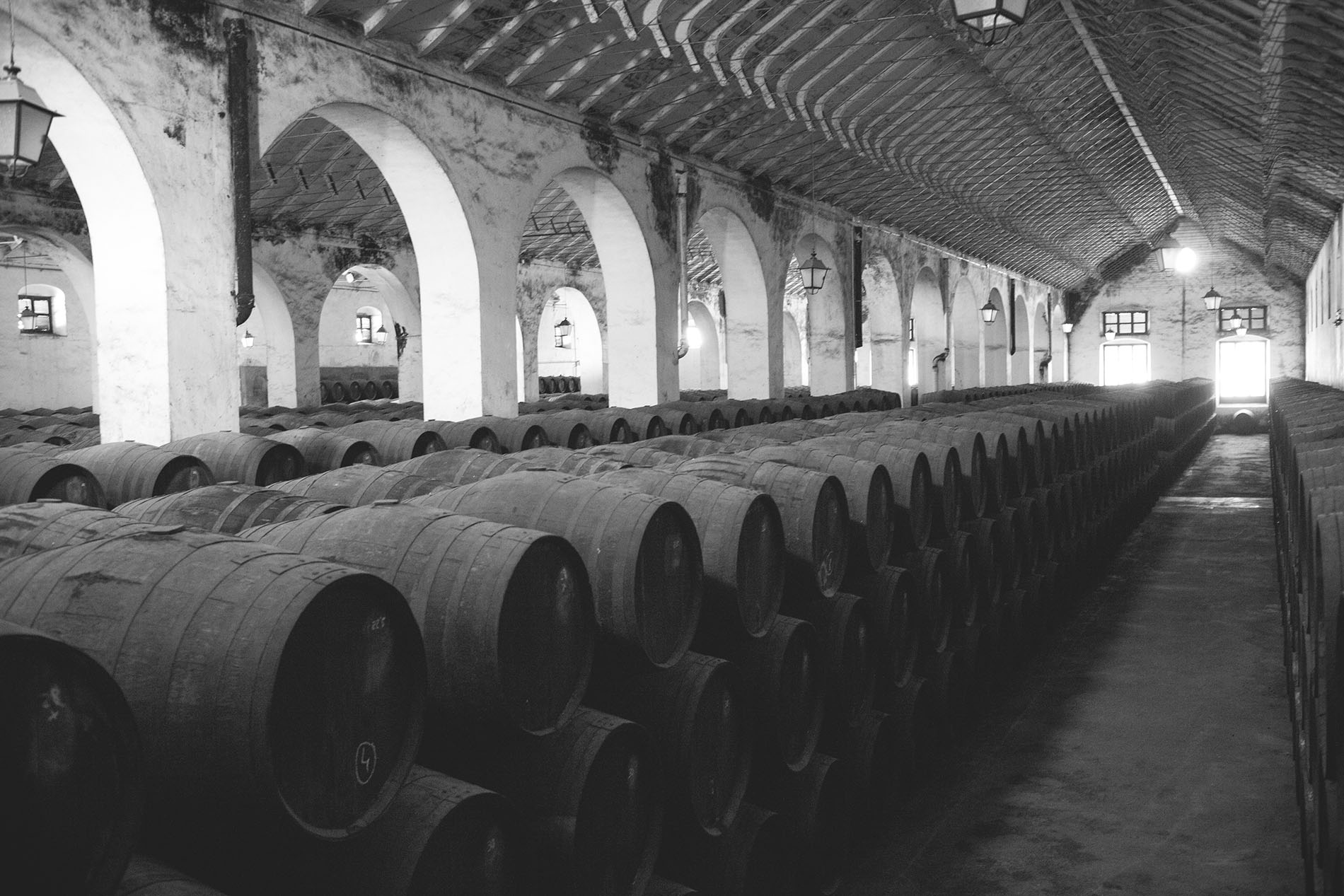
In the Los Amigos fine wine cellar alone, at Bodegas Pérez Barquero, there are 3,052 butts (barrels).
SUNDAY MORNING
Montilla; wineries, museums and taverns
The next day we wake early – to take advantage of the cool morning breeze – and set off for Montilla. A town only a 15 minutes drive away, prominent in the region, where there is a totally different offer of wineries, taverns and museums.
But wait, there is no need to rush to the town – at least not yet. We want to enjoy the drive along the winding roads of the undulating Sierra de Montilla and photograph some vineyard landscapes. We set a destination – on the GPS of the cell phone – to the Cerro de Don Juan, a viewpoint from which to contemplate the countryside and there we make a small stop.
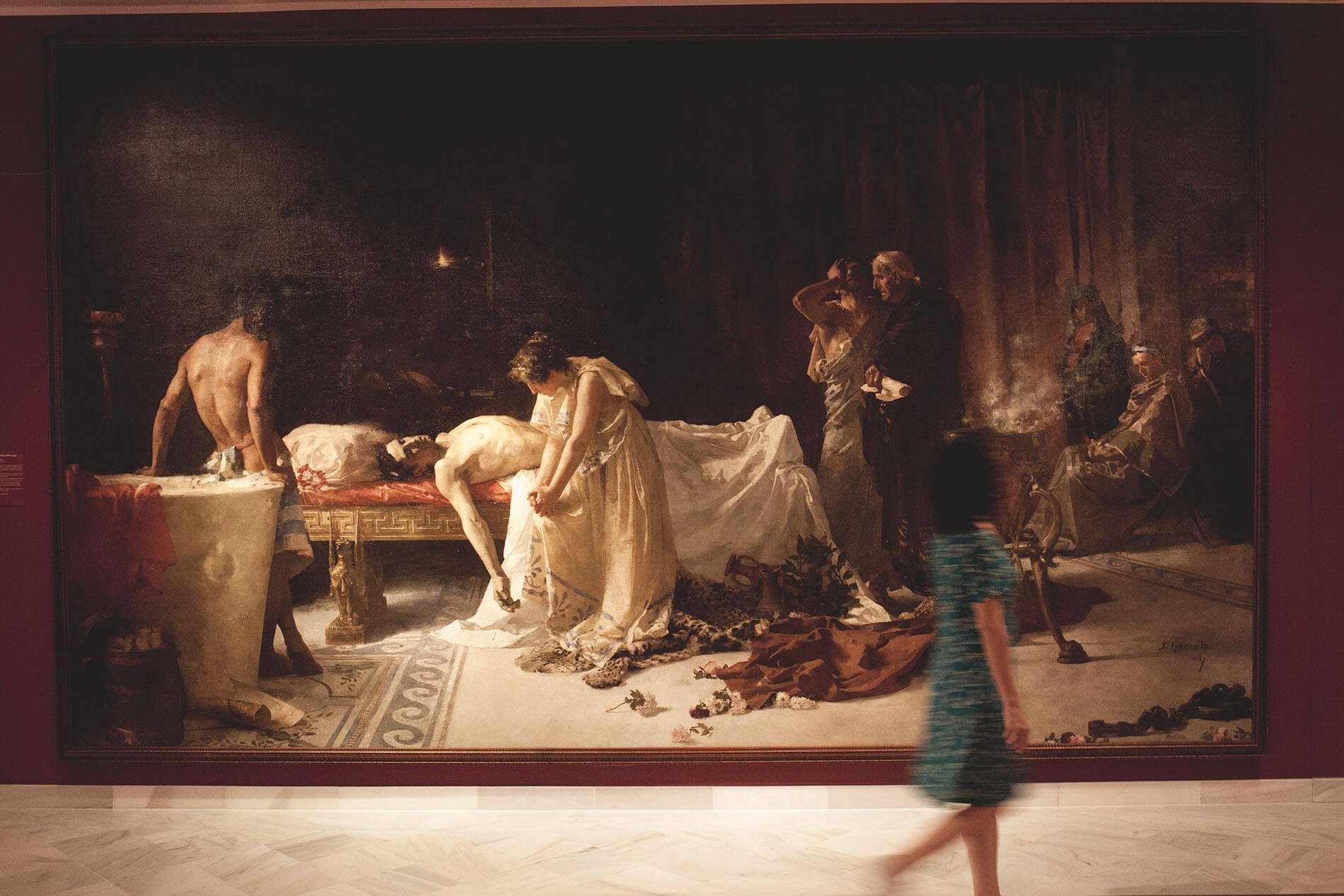
“The Death of Lucano” (1887), a work of 5×3.4 m, is one of the jewels of the Garnelo Museum in Montilla.
At 11 o’clock the Garnelo Museum opens, the museum of Picasso’s master, José Santiago Garnelo y Alda (1866-1944), considered the most cultured painter of his time, professor and researcher, teacher of Picasso and for years director of the Prado Museum. This year is the 75th anniversary of his death and in his honour, interesting activities have been programmed.
One of the largest paintings in the museum was restored in the Madrid art gallery and is one of the many jewels of the museum which we have come to see: The Death of Lucano (1877). There are also other beautiful works that make reference to the grape harvest, wine and the muses of the Montilla-Moriles region, such as La Bacante (1936) or Las Vendimiadoras (1892) by his sister Eloísa Garnelo. Tarde de Toros (1905) or the award-winning Jesús Manantial de Amor (1901) are some of the many great works you will find in this museum, which this year is organizing Garnelo routes in the town.
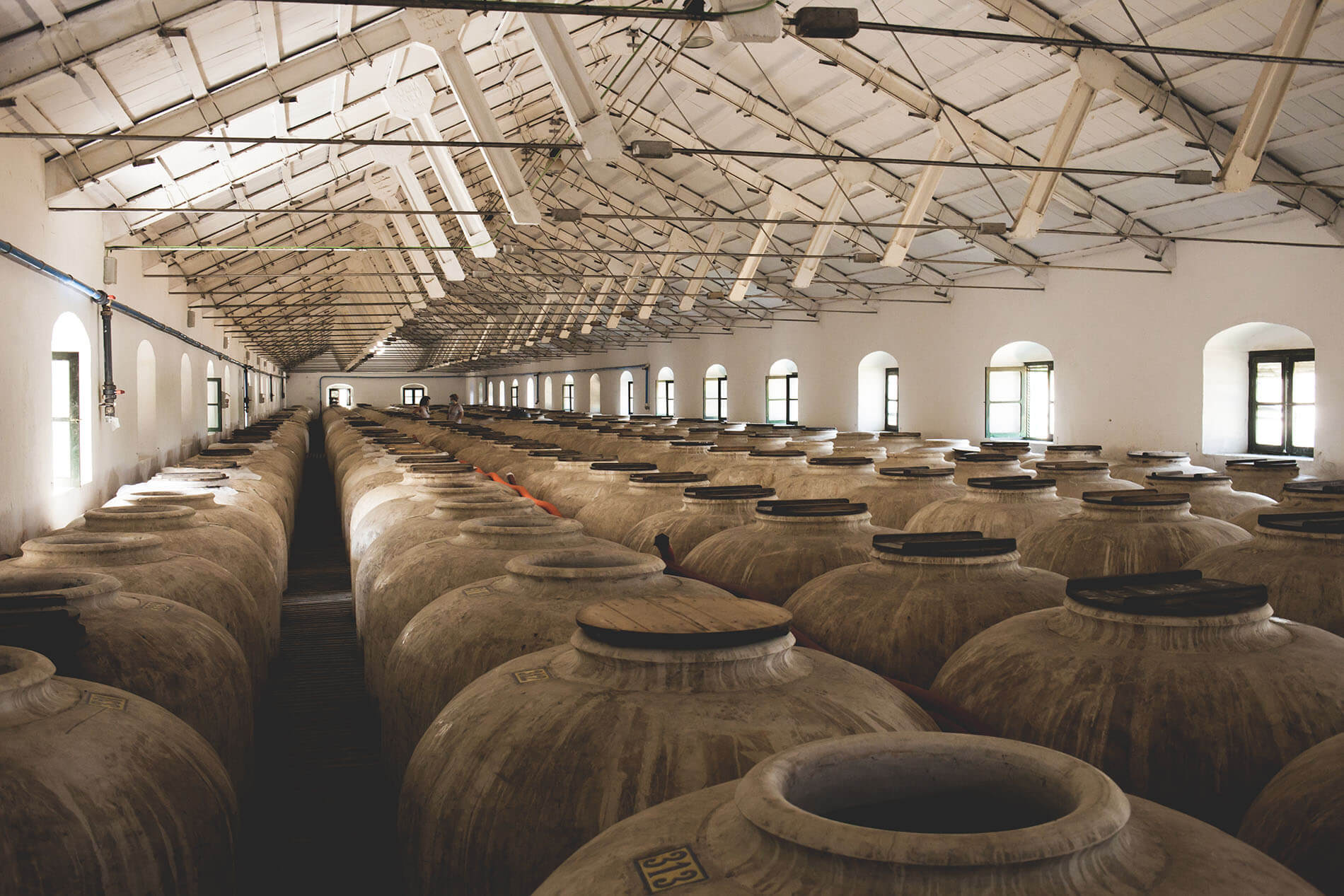
The vat cellars are one of the identifying features of the Montilla-Moriles region.
Bodegas Pérez Barquero; one of the most complete tour-tasting experiences
We finish the visit of the museum at wine o’clock. It is 12:30 pm and we are already at the entrance to Bodegas Pérez Barquero (usually closed on a Sunday, but as we had made a reservation the visit was possible). We chose this centenary winery because we were told that a visit around its installations is one of the most complete – especially in regards to the actual tasting, which takes place at the end of the tour of the winery. A real treat. The Bodegas Pérez Barquero, dating back to 1905, still has some of the original «soleras» from the year it was founded. In fact, its founding soleras have been awarded very high Parker Points -the one that obtained the maximum, 100 points, 1905 Amontillado Solera Fundacional, is currently sold out. Its century-old Monte Cristo Brandys also include authentic jewels.
Entering this winery gives you an idea of the magic and depth of some of its wines. Dark and silent cellars of finos, where the humidity in the ceiling speak of the needs these delicate finos require for their impeccable biological ageing under the veil of flor. In the Los Amigos cellar alone there are 3,052 butts, although the Pérez Barquero group, which also includes Bodegas Gracia, has 16,000 butts, some of them very old, because according to what we are told, the butts of the fortified wines, unlike those of the red wines, use the dynamic ageing system known as «criaderas y soleras». The visit ends with a tasting of five wines from their top-notch range. Superb.
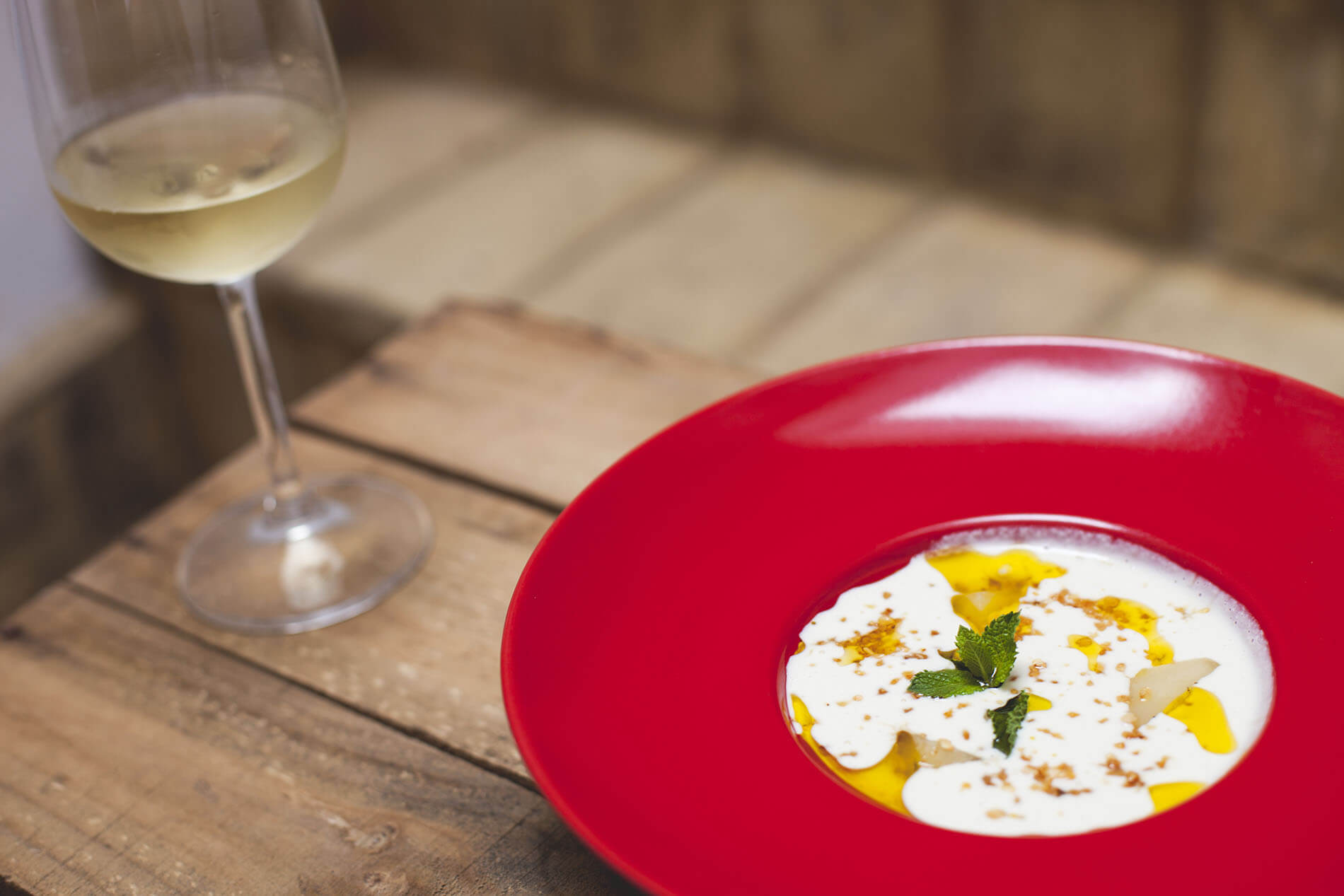
The mazamorra paired with a fruity, herbaceous Montilla-Moriles wine at the El Bolero tavern.
Taberna El Bolero; eat and drink very well and in good company
At lunchtime we have reserved a place in a local tavern that has become the spearhead of the local gastronomy, and pairs its dishes with the best wine of the Montilla-Moriles region. Carlos García, the person in charge, will tell you everything you want to know about this land.
The menu is full of dishes with a touch of design, paired perfectly with some of the wines we have been tasting. And although fish is its flagship, a good starter is Mazamorra Cordoba which goes well with a glass of fruity, herbaceous white wine Montilla-Moriles. Mazamorra is a traditional recipe from Cordoba whose origin is a cuisine which uses leftover ingredients. It is made with almonds, bread, olive oil, vinegar and bread, and the Taberna El Bolero also includes melon with an amontillado sangria with cinnamon that gives an explosion of flavours in the mouth. In addition, the crunchy almond gives it an original touch.
Good music is always played in the restaurant. The rest of the dishes paired with wines of the region are delicious and the desserts do not fall behind. And amidst laughter and a sweet wine like no other on earth, a black Pedro Ximénez as dark as night, we make the last toasts.
USEFUL INFORMATION
HOW TO GET THERE:
It takes approximately 34 minutes to drive from Cordoba to Espejo. At the RENFE train station in the capital, you can rent a car from €14 per day if you do not have your own vehicle or if you are en route through Andalusia.
WHERE TO STAY:
Casa Almara. Calle Trinidad Comas, 20, Espejo; tel. 644 59 31 04; Double room: from €60 / night
This is one of the best examples in the province of Cordoba of how to adapt a hundred-year-old house with modern-day comforts whilst maintaining its authenticity. This boutique hotel, with 8 rooms, offers intimacy, tranquillity and silence… Ambient music accompanies you during your stay. Homemade breakfasts, with homemade jams and bread loaves, with the possibility of eating the morning meal in the patio and then sunbathe on one of the terraces. They have family rooms and a door in the highest part of the hotel which opens up in front of the castle.
WHAT TO SEE:
Espejo Castle. Calle San Bartolomé, 16, Espejo; tel. 696 85 34 58; visits every day, by appointment, 40 minutes, ticket: €5 for groups of 10 people or less, and €4 for groups of more than 10 people. Children between 5 and 12 years pay €2.5. It is also possible to rent areas of the castle for events and private parties (ask for prices).
Pérez Barquero Winery. Avenida de Andalucía, 27, Montilla; tel. 957 650 500. Visits from Monday to Sunday, by appointment. Visits from €8, include tour of the winery and tasting of five wines from the winery, from its high end range: verdejo, fino, amontillado, oloroso, Pedro Ximénez. This is the basic tasting and most complete in the area. It is also possible to book the tasting with wine and tapas pairing, which works out like a lunch.
Other activities offered by the winery are cheese and Pedro Ximénez wine tasting, chocolate tasting, catering for lunches, night visits in summer, exclusive equestrian show, with the horse rider Angel Peralta and hot air balloon rides (ask in the winery for prices). The tour of the winery explains the complex process of elaboration of the fortified wines of the Montilla-Moriles region. It begins in the patio, decorated with old machinery and under which is the underground cellar of red wines, then passing through the unique cellar of vats, where young white wines are produced, the cellar of brandies, with barrels dating from 1885, and then to the area of large stainless steel tanks for fermentation, following on from there, to the cellar of fine wines Los Amigos and finally in the sacristy is the tasting.
Garnelo Museum. Plaza de Ángel Sisternes, Montilla; tel. 957 657 039; www.museogarnelo.org. Free entrance. Summer opening hours (until September 20): Tuesday to Friday, from 9 to 14.30; Saturday, Sunday and holidays, from 11 to 14 h. From September 20 they are also open in the afternoon from Tuesday to Saturday.
Every month, to celebrate the 75th anniversary, the museum will add to its website a video explaining one of Garnelo’s works. This September, the chosen work is the Grape Harvesters.
Ducal Palace of Fernán Núñez. Plaza de Armas, Fernán Núñez; tel. 957 38 21 24.
The programming of the III Palacio en Ruta took place on August 26 to September 1 at the Ducal Palace of Fernan Núñez, with poetic readings in the gardens and theatrical recitals. After these dates it is only possible to visit the exterior of the palace -which is, nonetheless, very beautiful-.
La Tercia-Mesón del Duque. Calle Cronista Alfonso Zurita, 14, Fernán Núñez. Open from Tuesday to Sunday from 9 am until midnight.
This historical place, perfect for breakfast and tapas, was originally built to market the wines of the Casa Condal produced in an adjacent winery. According to its current owner, Andrés Berral, at that time wine was also used to purify the water, which caused a lot of typhus. The estate that provided the wine, called La Viña, was wiped out during the phylloxera plague of 1875, which devastated the whole region. So the winepress was transformed into an olive oil mill, and was used as such until the end of the 50’s, the oil mill, the tavern and the barn (given to settlers in exchange for wheat or chickpeas) served as a warehouse for the curing of hams. In 1972, Andrés Berral reformed the whole site and unified the buildings, leaving the current Mesón del Duque as it is today.
WHERE TO EAT:
IN MONTILLA
Taberna Bolero, Calle Fuente Álamo, 9; tel. 679 39 80 02. Open from 12.30 noon to 3 o’clock in the morning.
In this centenary tavern, with charm, you will find a modern, seasonal menu, where fresh fish reigns on the menu. There are several dishes which pair well with Montilla-Moriles wines, such as the artichoke filled with oxtail and goat cheese cream, which goes perfectly with an aged amontillado, a fino Capataz from Bodegas Alvear, or a lighter amontillado from Bodegas Robles, not to mention its delicious croquettes with foie gras and mushrooms. For business meetings or groups that require more privacy, you can reserve the space of the old tavern cellar, which has a curious inverted vine lamp.
IN ESPEJO
The bars of Las Calleras are highly recommended for an informal dinner or tapas. A great spot for breakfast is in the Casino, a charming and unique place in the town located in an old manor house.
IN MONTEMAYOR
La Posada del Castillo, Calle Barreruelo; tel. 627 79 23 61.
For homemade meals at a good price in a cosy environment. It is also a good place for breakfast.

